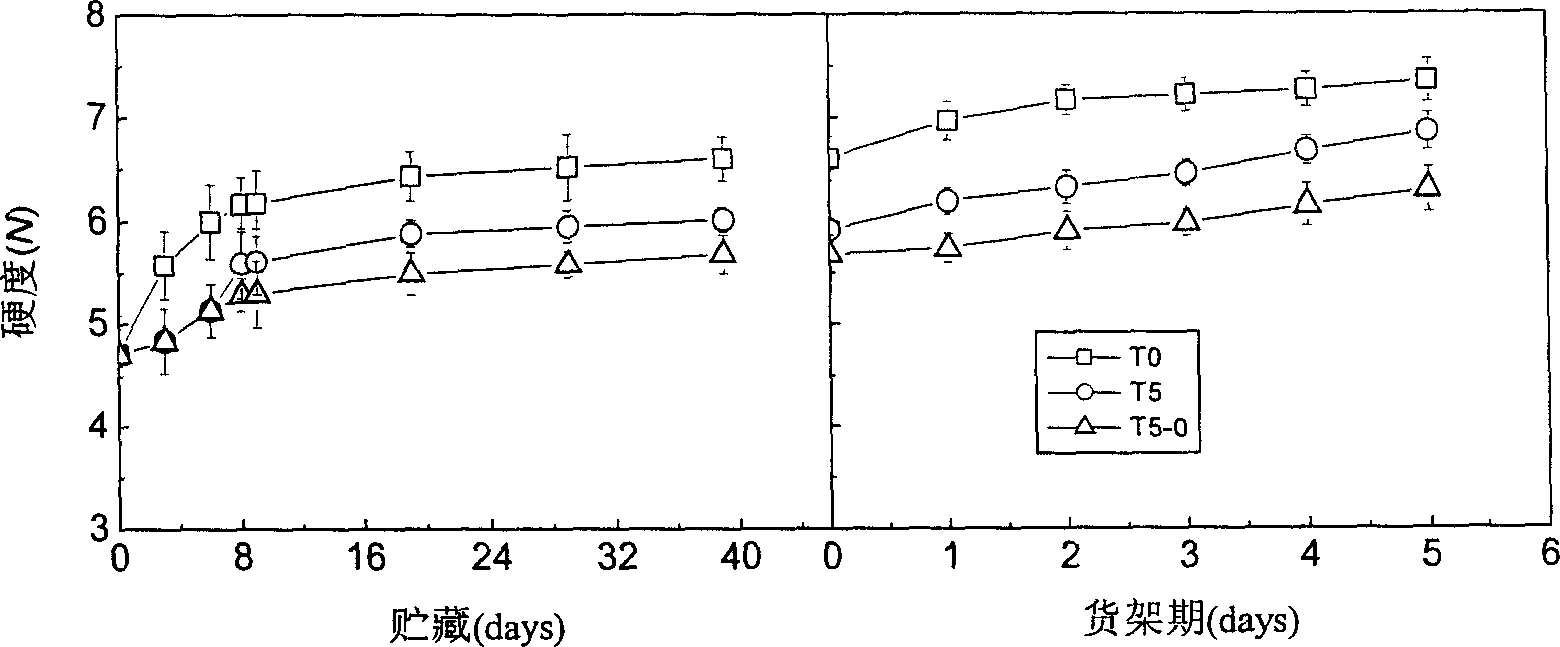Method for storing loquat fruit in low-temperature
A low-temperature storage and fruit technology, applied in the field of fruit storage, can solve the problems of unfavorable fruit quality, high input cost, tissue browning, etc., and achieve the effect of being suitable for large-scale operation, low input cost, and reducing cold damage symptoms
- Summary
- Abstract
- Description
- Claims
- Application Information
AI Technical Summary
Problems solved by technology
Method used
Image
Examples
Embodiment 1
[0010] Taking "Luoyang Qing" loquat as an example, fruits with uniform size, uniform maturity and no mechanical damage were selected and divided into three groups. The specific methods are shown in Table 1: the first group of fruits were first placed at the exercise temperature of 5 °C for 4 to 8 days, and then placed at 0 °C for storage for 33 days (T 5-0 ); the second group of fruits were directly stored at 0°C for 39 days (T 0 ); the third group of fruits were directly stored at 5°C for 39 days (T 5 ), with T 0 and T 5 as comparison. The main elements of using low temperature exercise are the temperature difference between the exercise temperature and the storage temperature, and the duration of the exercise, that is, to achieve the purpose of low temperature exercise, and to effectively maintain the product quality of the product.
[0011] Table 1 Low temperature tempering treatment of loquat fruit
[0012] Treatment Program Cooling Storage Temperature Storage Time Sh...
Embodiment 2
[0018] Using "Luoyang Qing" loquat fruit as material, different temperatures (0℃, 5℃ and 12℃ were used to study the 0 , T 5 and T 12 indicated) the storage effect. The results of the study are shown in Table 2, indicating that both 5°C and 12°C treatments can delay the increase in fruit firmness to varying degrees, reduce the browning of pulp and pericarp tissue, and maintain good fruit quality. For the decrease of titratable acid content, the comprehensive effect of 5 ℃ treatment is better than that of 12 ℃ treatment; although 0 ℃ storage can further delay the decline of soluble solids and titratable acid content, and better maintain the appearance quality and flavor of fruit, but Chilling damage occurs and lignification occurs. The loquat fruit that is directly refrigerated at low temperature (0-5°C) becomes difficult to peel, and the pulp changes from soft and juicy to hard texture, rough and less juicy, the fruit is easy to brown, and the pulp is lignified, which seriou...
Embodiment 3
[0029] Embodiment 3, implement the refrigeration method of table 1, namely the fruit is first placed in the exercise temperature of 5 ℃ for 6 days, and then placed at 0 ℃ for storage for 33 days (T 5-0 ), further experiments show that using T 5-0 The increasing trend of fruit firmness in programmed cooling storage was significantly smaller than that in T 0 and T 5 Treated fruit, after 39 days of storage 0 , T 5 , T 5-0 The fruit firmness of the treatments was 140%, 128% and 121% of its 0-day, respectively, results see figure 1 .
[0030] The lignin content of loquat fruit also tended to accumulate during cold storage, and different degrees of lignification appeared. T 5-0 The degree of lignification of the treated fruits was significantly lower than that of the T0 and T5 treated fruits. After 39 days of storage, T 0 , T 5 , T 5-0 The lignin contents of the treated fruits were 269%, 233% and 179% of their 0-day values, respectively, the results are shown in figure 2...
PUM
 Login to View More
Login to View More Abstract
Description
Claims
Application Information
 Login to View More
Login to View More - R&D
- Intellectual Property
- Life Sciences
- Materials
- Tech Scout
- Unparalleled Data Quality
- Higher Quality Content
- 60% Fewer Hallucinations
Browse by: Latest US Patents, China's latest patents, Technical Efficacy Thesaurus, Application Domain, Technology Topic, Popular Technical Reports.
© 2025 PatSnap. All rights reserved.Legal|Privacy policy|Modern Slavery Act Transparency Statement|Sitemap|About US| Contact US: help@patsnap.com


